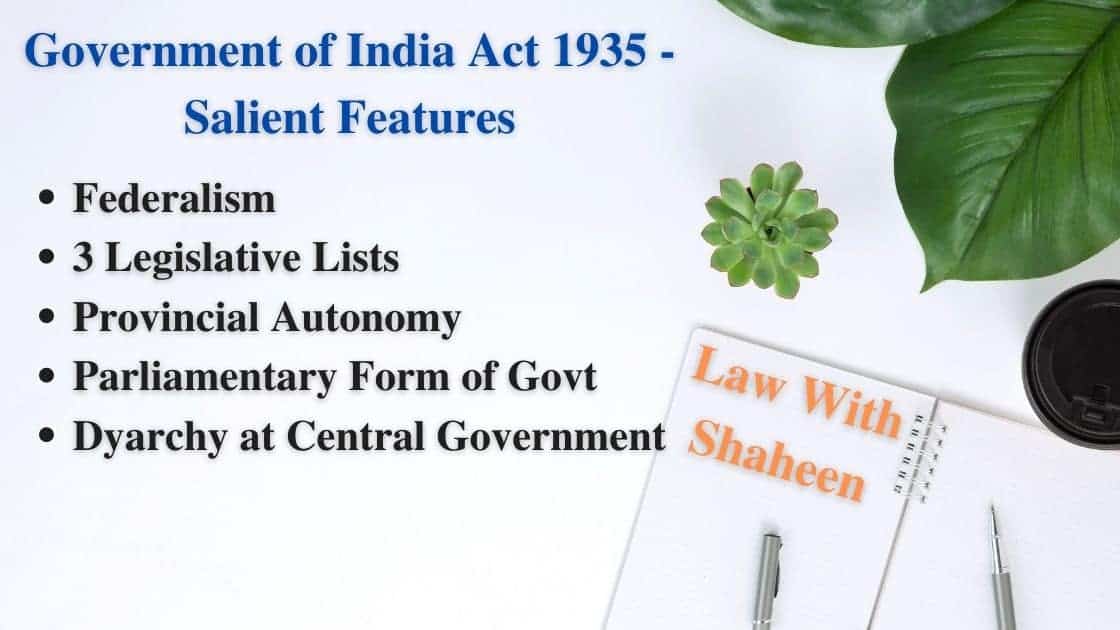Table of Contents
Government of India Act 1935:
The Government of India Act 1935 was enacted on the 1st of April 1937. The political parties considered it disappointing and dissatisfactory.
The famous Communal Award was announced by British Prime Minister Ramsay Macdonald in 1932. Next year the white paper also came into existence. A joint select committee was appointed which on November 22, 1934, give its report.
The Government of India Act 1935 was passed based on the report submitted by the joint select committee.
Salient Features of Government of India Act 1935:
The following are the salient features of the Government of India Act 1935:-
1). Written Act:
The Government of India Act 1935 was in written form which consisted of 14 parts and 10 schedules.
2). Federalism:
This act of 1935 proposed the Federation. With the introduction of the federation, the unitary form of government came to an end.
i). Division of powers:
The Powers should be distributed in such a manner that the Supremacy of the Centre and the regional autonomy should be preserved.
3). Division of State into Units:
The Government of India Act 1935 divided states into units.
4). 3 legislative lists:
This act of 1935 provided three legislative lists. They are as follows:
i). Federal Legislative list:
The Centre was authorized to legislate on all those matters which were enumerated in the federal legislative list.
a). Illustration:
Matters like defence, foreign affairs, and currency were given in the federal legislative list and the centre could legislate on them.
ii). Concurrent legislative list:
The center as well as provincial governments were authorized to legislate on all those matters which were enumerated in the concurrent legislative list.
a). Inconsistency Between Central Law and Provincial Law:
It was also provided that in case of inconsistency between central law and provincial law, the central law shall prevail.
iii). Provincial Legislative list:
The Provincial Government was authorized to legislate on those matters which were enumerated in the Provincial legislative list.
a). Illustration:
Matters like transportation and health were given in the provincial legislative list.
5). The Princely States:
As a requirement, the princely states had to join the federation but the princely states did not join the federation.
6). Provincial Autonomy:
The Government of India Act 1935 introduced Provincial autonomy. All the ministers were responsible to the legislature.
7). Provinces as Separate Legal Entities:
This act gave separate legal status to the provinces.
8). Responsible Government:
The Government of India Act of 1935 provided a responsible Government that had to be accountable for its acts.
9). 11 Governor Provinces:
This act also introduced the eleven Governor provinces.
10). 5 Chief Commissioner Provinces:
Another important feature of the Government of India Act of 1935 was that it created five chief commissioners provinces.
11). Parliamentary Form of Government:
The other important feature of the Government of India Act 1935 was that it proposed a Parliamentary form of Government.
12). Discretionary Powers of Governors:
The Governor-General enjoyed extensive powers. It was he who had to administer the matters given in the transferred and reserved subjects.
The powers of the ministers were limited. He could exercise special powers for financial stability, peace, and security and the protection of the rights of minorities.
13). Federal Legislature:
This act of 1935 also Introduced a bicameral legislature.
i). Council of State:
The Council of State was the upper house. It was a permanent house. Thirds of its members were elected every year. The total number of its members was 260.
a). Tenure:
The Council of Ministers was a permanent house.
b). Number of Members:
One-third of its members were elected every year. The total number of its members was 260.
ii). Federal Assembly:
The Federal Assembly was the lower house.
a). Tenure:
The term of the Federal Assembly was five years.
b). Number of Members:
It consisted of 375 members.
14). Provincial Franchise was Enlarged:
The Government of India Act 1935 also enlarged the provincial franchise.
15). Establishment of Federal Court:
This act also established the Federal Court in 1937.
16). Council of Ministers:
The creation of the Council of Ministers was to assist the Governor-General in his functions.
17). Executive and Legislative Supremacy to Federation:
This act of 1935 established the executive and legislative supremacy of the Federation.
18). Abolishment of Indian Council of the Secretary of State:
This 1935 act abolished the Indian Council of the Secretary of State.
19). Creation of the New Province of Sindh:
The Government of India Act 1935 created the new province of Sindh.
20). Checks on Legislatures:
This act introduced checks on the provincial and central legislature.
21). Dyarchy at Central Government:
This act of 1935 abolished the dyarchy from the provinces but it introduced it at the center.
Meaning of Dyarchy:
The term Dyarchy means, “Government shared by two rulers”.
a). Division of Federal Subjects:
The Federal subjects were divided into the following: –
- Reserved Subjects:
The following matters were in the reserved subjects:
- external affairs
- defence
- the administration of the Tribal Areas
- Transferred Subjects:
Other than reserved subjects, Transferred subjects had all other matters.
- Administration of Transferred Subjects:
The Governor-General with the assistance of the Council of Ministers had to administer the transferred subjects.
- Accountability of the Council of Ministers:
The council of ministers was accountable for its acts to two authorities. One was Governor-General and the other was the legislature.
